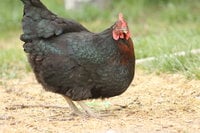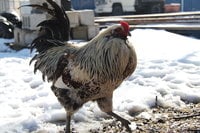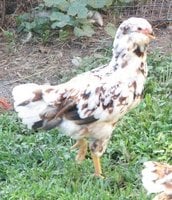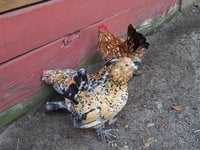I have four Black Sex-Link hens. They are about four years old and still lay as many eggs as they did when they were pullets. As layers you could scarcely ask for a better bird. They lay big brown eggs regularly. It's not uncommon for me to harvest three eggs a day from the batch of them, and sometimes four. They are friendly, resistant to disease, vigorous, and worth every penny you pay for them. Their only problems are that they don't go broody, and they are not pure breeds. But if your looking for good eggs and tame hens, these are an excellent choice.
Navigation
Install the app
How to install the app on iOS
Follow along with the video below to see how to install our site as a web app on your home screen.
Note: This feature may not be available in some browsers.
More options
You are using an out of date browser. It may not display this or other websites correctly.
You should upgrade or use an alternative browser.
You should upgrade or use an alternative browser.
Reviews by Gresh
Filters
Show only:
Loading…
- Gresh
- 5.00 star(s)
Pros: outstanding production, hybrid vigor, disease resistance, tame, friendly
Cons: not broody, not a pure breed
- Gresh
- 5.00 star(s)
Pros: Multi-Climate, Multi-Purpose (meat, eggs, pets, entertainment, etc.), Genetically Diverse, Readily Available
Cons: Traits not always passed down to young
I've kept many chickens ever since I started raising them in 2011. I've raised bantams (d'Uccles, Old English, Minorca), hybrids (Red Sex-links, Black Sex-links), hatchery mutts (sold as purebreeds, but that doesn't mean a thing coming from a hatchery), and a wonderfully friendly Oriental gamecock. The Easter Egger trumps all of them.
The Easter Egger is a multi-climate chicken. My EE's have withstood high temperatures and low temperatures alike with ease. They make good egg-layers (I usually have a surplus in the fridge), and although I've never eaten any of my birds, I have heard that their meat is tasty. They tend to be smaller than some multi-purpose breeds (the females, in particular, look like oversized bantams), but this means that they can fly well, which is a great advantage if you free-range them like I do (my hens can fly for many feet like pros when startled or excited). The roosters are not "clingy" to people but are by no means aggressive. The hens lay eggs that are surprisingly large, considering the size of the birds; and the colors of mine range from pale turquoise to a tinted white.
EE's are not flighty, so they will make good selections for kids (assuming your kids are well-mannered and will not try to do mean things to the birds). The hens enjoy human contact, and all of my hens have occasionally sat in my lap for several minutes, quite contentedly. They are easy to pick up and hardly ever struggle (mine relax almost as soon as I pick them up). The roosters are harder to catch but never bite when handled. I have never been spurred by my roosters.
My EE's have shown good disease resistance.
Perhaps the only major problem with EE's is that, because they are not a pure breed, you could breed them and get very different traits in their offspring at the outset of your breeding venture. However, with time (and assuming you are selective in breeding), you could maintain a relatively genetically stable flock with good chances of passing on their traits to their young.
EE's make great birds for beginners, amateurs, and professionals alike. If you're looking for a good starting point for your chicken-keeping, get some Easter Eggers!
The Easter Egger is a multi-climate chicken. My EE's have withstood high temperatures and low temperatures alike with ease. They make good egg-layers (I usually have a surplus in the fridge), and although I've never eaten any of my birds, I have heard that their meat is tasty. They tend to be smaller than some multi-purpose breeds (the females, in particular, look like oversized bantams), but this means that they can fly well, which is a great advantage if you free-range them like I do (my hens can fly for many feet like pros when startled or excited). The roosters are not "clingy" to people but are by no means aggressive. The hens lay eggs that are surprisingly large, considering the size of the birds; and the colors of mine range from pale turquoise to a tinted white.
EE's are not flighty, so they will make good selections for kids (assuming your kids are well-mannered and will not try to do mean things to the birds). The hens enjoy human contact, and all of my hens have occasionally sat in my lap for several minutes, quite contentedly. They are easy to pick up and hardly ever struggle (mine relax almost as soon as I pick them up). The roosters are harder to catch but never bite when handled. I have never been spurred by my roosters.
My EE's have shown good disease resistance.
Perhaps the only major problem with EE's is that, because they are not a pure breed, you could breed them and get very different traits in their offspring at the outset of your breeding venture. However, with time (and assuming you are selective in breeding), you could maintain a relatively genetically stable flock with good chances of passing on their traits to their young.
EE's make great birds for beginners, amateurs, and professionals alike. If you're looking for a good starting point for your chicken-keeping, get some Easter Eggers!
- Gresh
- 5.00 star(s)
Pros: Hardy, active, larger size, capable defender, good winter layer, gamey looks
Cons: many strains aren't very broody, laying ability varies with lines, some American bloodlines have been doped with Sussex blood
Russian Orloffs are a great breed to keep. Their history dates back to the 1700s when they originated as a farm fowl in Persia. Since then, they have been bred with Malays and muffed fowl from Europe to produce the beautiful bird they are today.
Russian Orloffs are quite rare in the United States due to breeding Sussex blood into the Spangled strains, thereby producing a mutt offspring instead of the real deal. The main sign of Sussex breeding in Orloff strains is white-colored legs. Purebred Orloffs have yellow legs. Orloffs are in need of preservation due to their rarity, and there has been a rising interest in this breed over the past few years.
Orloffs are extremely cold hardy and are known to lay straight through the winter. They are disease-resistant, gamey-looking fowl with a stance similar to many Oriental gamefowl. Males are good defenders of their flocks. The Orloff's unique appearance and simple beauty make them a must-have for your backyard flock.
Russian Orloffs are quite rare in the United States due to breeding Sussex blood into the Spangled strains, thereby producing a mutt offspring instead of the real deal. The main sign of Sussex breeding in Orloff strains is white-colored legs. Purebred Orloffs have yellow legs. Orloffs are in need of preservation due to their rarity, and there has been a rising interest in this breed over the past few years.
Orloffs are extremely cold hardy and are known to lay straight through the winter. They are disease-resistant, gamey-looking fowl with a stance similar to many Oriental gamefowl. Males are good defenders of their flocks. The Orloff's unique appearance and simple beauty make them a must-have for your backyard flock.
- Gresh
- 5.00 star(s)
Pros: friendly, attractive, good free ranger, good flier
Cons: too small to fight off predators, feathered feet inhibit running
Some of the first chickens I owned were Belgian d'Uccle bantams. I had a male Mille Fleur and a female White. They were two of the sweetest chickens we ever owned. Both of them were of good quality, and the male was particularly beautiful, and with every molt his feathers came back more and more brilliant. The female took a long time to come into lay, but I think this was because she had coccidiosis when she was young. However, when she finally started laying, she laid fairly consistently, and it was always so adorable to see her tiny egg laid in the same clutch as those of the larger birds in the flock. Both of them could fly extremely well. They were very tame when handled and sometimes sought out our companionship.
Unfortunately, our hen was taken (presumably by a fox) without a trace, and our cock died while in the care of an irresponsible poultry keeper who was watching the birds while my family and I were moving. However, I will always cherish the memory of "Bilbo" and "Edwina."
If you have kids, these birds are the choice for you.
Unfortunately, our hen was taken (presumably by a fox) without a trace, and our cock died while in the care of an irresponsible poultry keeper who was watching the birds while my family and I were moving. However, I will always cherish the memory of "Bilbo" and "Edwina."
If you have kids, these birds are the choice for you.
- Purchase Date
- 1970-01-01




